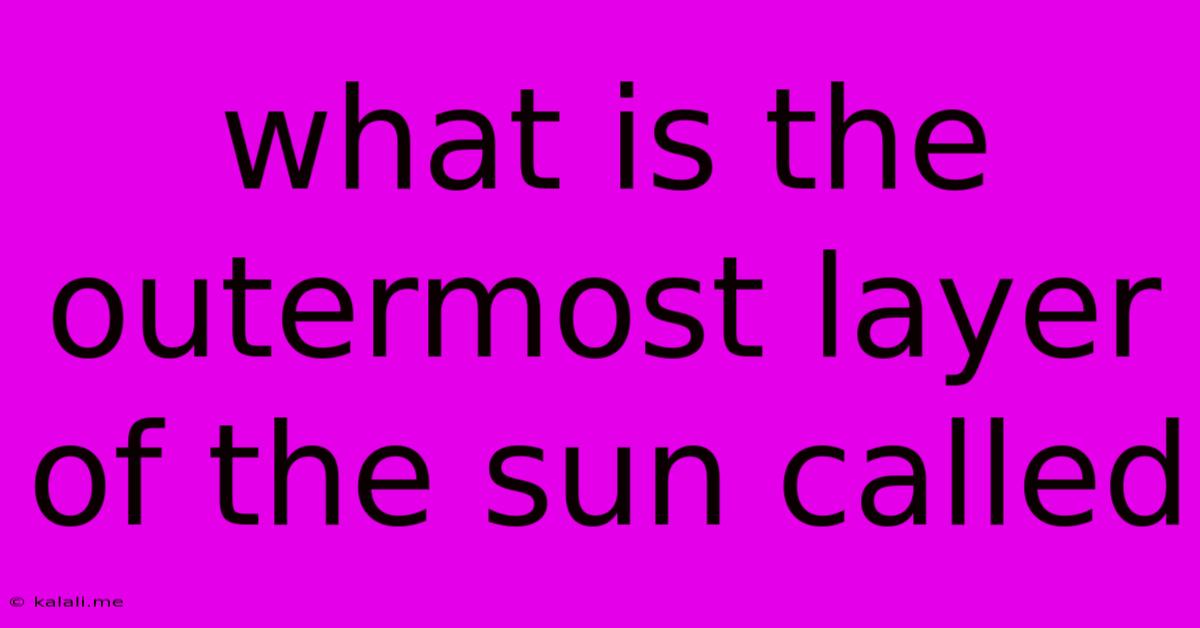What Is The Outermost Layer Of The Sun Called
Kalali
May 10, 2025 · 3 min read

Table of Contents
What is the Outermost Layer of the Sun Called? Understanding the Sun's Atmosphere
The Sun, our nearest star, is a complex and dynamic celestial body. Its structure is layered, much like an onion, with each layer possessing unique characteristics and playing a vital role in the Sun's overall function. Understanding these layers is key to grasping solar phenomena and their impact on Earth. This article will delve into the outermost layer of the Sun, exploring its properties and significance. The answer is straightforward: it's called the corona.
The Sun's outermost layer is the corona, a dazzling halo of plasma that extends millions of kilometers into space. Unlike the inner layers, which are primarily governed by pressure, the corona's dynamics are heavily influenced by magnetic fields. This makes it a fascinating and often unpredictable region, responsible for many of the spectacular solar events we observe.
Characteristics of the Solar Corona
The corona is incredibly hot, reaching temperatures of millions of degrees Celsius – significantly hotter than the Sun's surface, which sits at around 5,500 degrees Celsius. This temperature discrepancy remains a scientific puzzle, and ongoing research aims to uncover the mechanisms driving this intense heating.
Several key features distinguish the corona:
- Extreme Temperatures: As mentioned, the corona's extreme temperatures are a defining characteristic.
- Low Density: Despite its high temperature, the corona is remarkably thin. Its density is extremely low, meaning it contains fewer particles per unit volume compared to other solar layers.
- Magnetic Field Dominance: The Sun's magnetic field plays a dominant role in shaping the corona's structure. Magnetic field lines loop and arch outwards, creating intricate patterns visible during solar eclipses.
- Solar Wind Origin: The corona is the source of the solar wind, a continuous stream of charged particles that flows outwards into the solar system.
- Coronal Mass Ejections (CMEs): These are massive bursts of plasma and magnetic field that erupt from the corona. CMEs can have significant consequences for Earth, impacting our satellites and power grids.
- Visible During Solar Eclipses: The corona is best visible during a total solar eclipse, when the Moon blocks the Sun's bright surface, allowing the fainter corona to shine through. Its ethereal glow has captivated observers for centuries.
The Corona and its Impact on Earth
The corona's activity directly impacts Earth. While the solar wind provides a constant stream of particles, coronal mass ejections (CMEs) are more dramatic events. These powerful eruptions can cause geomagnetic storms, disrupting radio communications, satellite operations, and even power grids. Studying the corona, therefore, is crucial for understanding space weather and mitigating its potential effects.
Beyond the Corona: The Heliosphere
It is important to note that the corona doesn't mark the absolute end of the Sun's influence. The solar wind continues to travel far beyond the corona, forming the heliosphere, a vast bubble of charged particles that encompasses the entire solar system. The heliosphere acts as a protective barrier, shielding us from much of the interstellar radiation.
Understanding the outermost layer of the Sun, the corona, provides valuable insights into solar dynamics, space weather, and the Sun's impact on Earth. Further research continues to unravel the mysteries of this remarkable region, enhancing our knowledge of our star and its influence on our planet.
Latest Posts
Latest Posts
-
Jaguar Adaptations In The Tropical Rainforest
May 10, 2025
-
How To Find Average Velocity From Velocity Time Graph
May 10, 2025
-
What Is Non Living Things In The Ecosystem
May 10, 2025
-
How Many Fl Oz In 6 Cups
May 10, 2025
-
What Is 1 Percent Of 5000
May 10, 2025
Related Post
Thank you for visiting our website which covers about What Is The Outermost Layer Of The Sun Called . We hope the information provided has been useful to you. Feel free to contact us if you have any questions or need further assistance. See you next time and don't miss to bookmark.